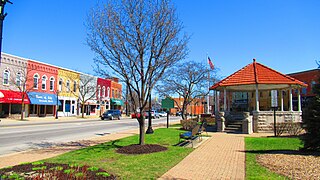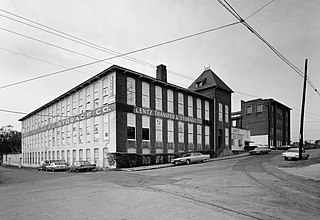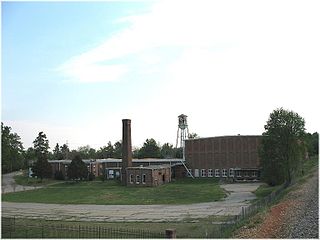Thomas Franklin Lloyd is one of the founders of Carrboro, North Carolina. He was a prominent North Carolina industrialist who built the Alberta Cotton Mill in 1898 in Carrboro; the former factory building is now home to the Carr Mill Mall.

The Hope Village Historic District is a historic rural mill settlement within Hope Village in Scituate, Rhode Island. Hope Village is located on a bend in the North Pawtuxet River in the southeastern corner of Scituate. Industrial activity has occurred in Hope Village since the mid-eighteenth century. Surviving industrial and residential buildings in the Historic District date back to the early 19th century. The village center sits at junction of Main Street and North Road. Hope Village radiates out from the center with houses on several smaller side streets in a compact configuration. Currently there is little commercial or industrial activity in Hope Village and none in the Historic District. The present stone mill building on the south side of Hope Village was built in 1844 by Brown & Ives of Providence, expanded in 1871 and modified in 1910. Approximately one quarter of the village's current housing stock was built as mill worker housing by various owners of Hope Mill.

Piedmont Number One is a former textile plant and former National Historic Landmark in Piedmont, Greenville County, South Carolina. It burned in 1983.

Pilgrim Mills is an historic textile mill located at 847 Pleasant Street in Fall River, Massachusetts. The mill was built in 1911 from red brick and was the first mill in the city powered entirely by electricity, provided from the local grid. It was one of the last mill complexes built in the city. The property was listed on the National Register of Historic Places in 1983.

The Village of Monroe Historic District, also known as the Smith's Mill Historic District, is located in Monroe, New York, United States. It is an irregularly shaped 81-acre (33 ha) area containing 36 properties, primarily residential but with some churches and commercial buildings, in the center of the village, just east of its downtown. In 1998 it was listed on the National Register of Historic Places.

The Dundee Historic Village is a historic district located in Dundee, Michigan. The district was added to the National Register of Historic Places on August 20, 1990. This area is commonly referred to as the downtown area of Dundee and was settled almost concurrently with the Old Village Historic District in nearby Monroe. Both were built in their respective locations due to the River Raisin. Originally, the buildings within the district were small, wood buildings, but these were eventually replaced with two-story, brick storefronts. Most of the surviving buildings were built between 1866 and 1900, although the district traces its origins to Dundee's establishment in 1825.

Mills Mill was a textile mill in Greenville, South Carolina (1897-1978) that in the 21st century was converted into loft-style condominia. The building is listed on the National Register of Historic Places.

Woodside Cotton Mill Village Historic District is a national historic district located in Greenville County, South Carolina. The district encompasses 278 contributing buildings and 2 contributing sites in an early 20th century urban South Carolina textile mill village. Centered on a mill founded by John T. Woodside in 1902, the district is located just west of the city limits of Greenville and is largely intact despite modernizations made by a succession of mill and home owners. The mill itself is a rectangular, brick, four-story building designed by J.E. Sirrine and built between 1902 and 1912. Eventually the mill became the largest cotton mill under one roof in the United States and one of the largest in the world.

Rock Hill Cotton Factory, also known as Plej's Textile Mill Outlets, Ostrow Textile Mill, and Fewell Cotton Warehouse, is a historic textile mill complex located at Rock Hill, South Carolina. The mill was built in 1881, and is a two-story, 12 bay by 16 bay, brick factory. It features a three-story tower at the main entrance. A number of additions have been made to the building. The Fewell Cotton Warehouse is a one-story, brick and wood frame warehouse built before 1894.

The Cocheco Mills comprise a historic mill complex in the heart of Dover, New Hampshire. The mills occupy a bend in the Cochecho River that has been site of cotton textile manufacturing since at least 1823, when the Dover Manufacturing Company supplanted earlier sawmills and gristmills. The present mill buildings were built between the 1880s and the early 20th century, and were listed on the National Register of Historic Places in 2014.
Dunavant Cotton Manufacturing Company, also known as Alpine Cotton Mill No. 1, is a historic cotton mill located at Morganton, Burke County, North Carolina. It is a two-story, brick-clad, side gable-roofed building. The original section was built in 1888–1910, with additions and expansions through 1966. The additions to the building, made in the mid to late 1960s were removed in 2012 to reveal the original 1888-1910 mill building. It is the oldest cotton textile mill in Morganton, and was in use as a cotton textile mill until 1949.

Durham Hosiery Mill is a historic textile mill complex located at Durham, Durham County, North Carolina. It includes seven contributing brick buildings in the complex. The original Durham Hosiery Mill was built in 1902, and consists of a four-story main building with a six-story Romanesque Revival-style tower in front; engine, boiler, and heater houses attached at the rear, and a one-story dye house. The main building was expanded with a two-story annex in 1904, and a three-story annex in 1906. Other buildings include the triangular Annex No. 1 (1912) and a three-story brick finishing building. By 1910, the Durham Hosiery Mills Corporation was the largest manufacturer of cotton hosiery in the world. The mill was abandoned in 1922.

Erwin Cotton Mills Company Mill No. 1 Headquarters Building, also known as Erwin Square, is a historic textile mill complex located at Durham, Durham County, North Carolina. The mill was built in 1892, and is a two-story, 748 feet long, brick building. It features three square towers projecting from the east facade and hundreds of large and closely spaced windows. The building exemplifies "slow burn" construction with its exterior load bearing brick walls and its heavy timber heart pine beams and columns. The headquarters building is a Late Victorian style brick building built in 1892 and enlarged in 1896 and 1905. Attached to the headquarters building is a warehouse. In 1983–1984, the complex was renovated as offices and apartments.

Arista Cotton Mill Complex, also known as Salem Cotton Manufacturing Company and Arista Cotton Mill and Lentz Transfer & Storage Co., is a historic cotton mill complex located at Winston-Salem, Forsyth County, North Carolina. The complex includes two buildings: a brick building built in 1836 by part of the Moravian congregation of Salem and the original home of the Salem Cotton Manufacturing Company, and the other is the original Arista Mill, built in 1880 by F. and H. Fries Cotton Arista Mills. The 1836 Salem Cotton Mill is a three-story, brick building with a monitor roof. The 1880 mill is a three-story brick building, 14 bays long, with bracketed eaves with timber supports. A two-story roughly triangular brick building was added about 1900. The 1836 building has been converted to a hotel known as The Historic Brookstown Inn.

Sterling Cotton Mill, also known as the Franklinton Cotton Mill, is a historic cotton mill complex located at 108-112 East Green Street in Franklinton, Franklin County, North Carolina. The main mill is a one and two-story L-shaped brick building with Industrial Italianate style design elements. The mill consists of five sections: the original gabled one-story section rising to a two-story section at the east end (1895); a two-story addition (1914), a one-story addition (1960s); pre-1926 "cotton sheds"; and a small two-story brick office (1966). Associated with the mill is the contributing detached chimney stack. The mill was built by Samuel C. Vann, whose son Aldridge built the Aldridge H. Vann House. The mill closed in 1991.
Mount Holly Cotton Mill, also known as Alsace Manufacturing Co., is a historic cotton mill complex located at Mount Holly, Gaston County, North Carolina. The original section was built in 1875, and is a 3 story, rectangular brick mill building with Industrial Italianate detailing. A three-story addition was built in 1916, and a one-story, T-plan brick machine shop and boiler house was added in 1919. The complex was converted into a research unit in 1953, and in 1973 was sold to an independent mill operator who presently uses the building for a variety of industrial and commercial purposes.

Oakdale Cotton Mill Village is a historic textile mill, mill village, and national historic district located at Jamestown, Guilford County, North Carolina, United States. The district encompasses 37 contributing buildings including the Logan Manufacturing Company complex built during the 1880s and 33 frame mill worker houses dated to the early-20th century. The factory complex consists of a three-story rectangular brick office, a one and two-story L-shaped brick factory with a four-story tower and five one-story brick warehouses, a small one-story board-and-batten blacksmith shop, and a polygonal brick smokestack.

Eureka Manufacturing Company Cotton Mill, also known as Tait Yarn Company and Lincoln Bonded Warehouse Company, is a historic cotton mill located at Lincolnton, Lincoln County, North Carolina. It was built between 1907 and 1910, and is a two-story, brick factory building with a three-story stair tower. Adjacent to the factory is a two-story brick office building built between 1902 and 1906. The buildings housed the Eureka Manufacturing Company from 1906 to 1937, and Tait Yarn Company from 1949 to 1966. Lincoln Bonded Warehouse occupied the buildings into the late-1990s. The buildings are owned by the Lincoln County Historical Association.

Textile Mill Supply Company Building is a historic factory building located at Charlotte, Mecklenburg County, North Carolina. It was designed by Lockwood, Greene & Co. and built in 1922. It is a three-story, ten-bay wide by-five-bay deep, red brick structure with a full basement. It has large rectangular windows and pine post-and-beam interior framing. The building housed the Textile Mill Supply Company that sold and distributed supplies essential to the operations of textile mills in the Piedmont sections of the Carolinas.

The Pontiac Commercial Historic District is a primarily commercial historic district located roughly along East Huron and South Saginaw Streets, within loop of Wide Track Drive, in Pontiac, Michigan. The core of the district, within the block bounded by Saginaw, Lawrence, Pike, and Wayne Streets, was originally listed on the National Register of Historic Places in 1984. A boundary increase creating the present boundaries was listed in 1989. The district includes the Eagle Theater and the Grinnell Brothers Music House, also listed on the National Register.





















